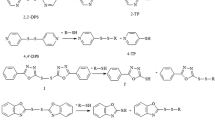Abstract
A molecule of the major blood protein albumin contains 34 cysteine residues involved in disulfide bonds and one unpaired SH-group of residue Cys34. Normally, 20–30% of these SH-groups are oxidized and form disulfide bonds or the derivatives of sulfenic, sulfinic, and sulfonic acids. The goal of the present work was to study the influence of the degree of oxidation of sulfhydryl groups on the capacity of albumin for glycation. Commercially available human albumin containing 0.4 moles of sulfhydryl groups per 1 mole of the protein (nonmercaptalbumin) was used. Disulfide bonds in this preparation were reduced with dithiothreitol to 0.7 mole/mole to give mercaptalbumin. The preparations were incubated for three weeks with glucose at a concentration of 5 and 50 mM. The content of ketoamine, a glycation product, was determined by the colorimetric method, the content of pentosidine (glycation end product) was analyzed by fluorescence, and the content of SH-groups was determined using the Ellman’s reagent. Changes in the structure and properties of the protein during glycation were studied by fluorescence and HPLC. During the incubation of both albumin preparations with 5 mM glucose, no significant increase in the ketoamine content was observed, whereas the incubation with 50 mM glucose was accompanied by a considerable accumulation of ketoamine. It was found that the greatest amount of ketoamine under these conditions forms in nonmercaptalbumin; in this case, the intensity of tryptophan fluorescence decreases. The intensity of pentosidine fluorescence increases with increasing content of ketoamine. The results obtained enable the conclusion that the oxidation of free SH-groups of the protein changes its conformation; as a result, the glycation of earlier hidden sites becomes possible, and the degree of protein glycation increases.
Similar content being viewed by others
Abbreviations
- GEP:
-
glycation end product
- M- and NM-albumin:
-
mercapt- and nonmercaptalbumin
- HSA:
-
human serum albumin
References
Anguizola, J., Matsuda, R., Barnaby, O.S., Hoy, K.S., Wa, C., Bolt, E., Koke, M., and Hage, D.S, Clin. Chim. Acta, 2013, vol. 425, pp. 64–76.
Rondeau, P. and Bourdon, E, Biochimie, 2011, vol. 93, pp. 645–658.
Oettl, K. and Stauber, R.E, British J. Pharmacol, 2007, vol. 151, pp. 580–590.
Hayashi, T., Era, S., Kawai, K., Imai, H., Nakamura, K., Onda, E., and Yoh, M, Pathophysiology, 2000, vol. 6, pp. 237–243.
Wa, C., Cerny, R.L., Clarke, W.A., and Hage, D.S, Clin. Chim. Acta, 2007, vol. 385, pp. 48–60.
Singh, V.P., Bali, A., Singh, N., and Jaggi, A.S, Korean J. Physiol. Pharmacol., 2014, vol. 18, pp. 1–14.
Ahmad, S. and Moinuddin Ali, A, Life Sci., 2012, vol. 90, pp. 980–987.
Vlassopoulos, A., Lean, M.E., and Combet, E, Free Radic. Biol. Med., 2013, vol. 60, pp. 318–324.
Shaklai, N., Garlick, R.L., and Bunn, H.F., J. Biol. Chem., 1984, vol. 259, pp. 3812–3817.
Ali Khan, M.V., Rashid, Z, Ali Khan, V., and Ali, R, Biokhimiya, 2007, vol. 72, pp. 175–183.
Bohney, J.P. and Feldhoff, R.C, Biochem. Pharmacol., 1992, vol. 43, pp. 829–1834.
Guerin-Dubourg, A., Catan, A., Bourdon, E., and Rondeau, P, Diabetes Metab., 2012, vol. 38, pp. 171–178.
Mashiba, S., Uchida, K., Okuda, S., and Tomita, S, Clin. Chim. Acta, 1992, vol. 212, pp. 3–15.
Baraka-Vidot, J., Guerin-Dubourg, A., Bourdon, E., and Rondeau, P, Biochimie, 2012, vol. 94, pp. 1960–1967.
Szkudlarek, A., Maciazek-Jurczyk, M., Chudzik, M., Równicka-Zubik, J., and Sulkowska, A, Spectrochim. Acta A. Mol. Biomol. Spectrosc., 2016, vol. 153, pp. 560–565.
Aitken, A. and Learmonth, M, Methods Mol. Biol., 1997, vol. 64, pp. 317–328.
Levine, R.L., Garland, D., and Oliver, C.N, Methods Enzymol., 1990, vol. 186, pp. 464–478.
Dawson, R.M.C., Elliott, D.C., Elliott, W.H., and Jones, K.M., Data for Biochemical Research, Oxford, England: Clarendon Press, 1986; Moscow: Mir, 1991.
Author information
Authors and Affiliations
Corresponding author
Additional information
Original Russian Text © N.Yu. Lotosh, S.V. Savel’ev, A.A. Selishcheva, 2016, published in Bioorganicheskaya Khimiya, 2016, Vol. 42, No. 6, pp. 689–696.
Rights and permissions
About this article
Cite this article
Lotosh, N.Y., Savel’ev, S.V. & Selishcheva, A.A. Modification of albumin with different degrees of the oxidation of SH-groups in the reaction with glucose. Russ J Bioorg Chem 42, 624–630 (2016). https://doi.org/10.1134/S1068162016050101
Received:
Accepted:
Published:
Issue Date:
DOI: https://doi.org/10.1134/S1068162016050101




